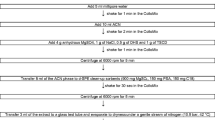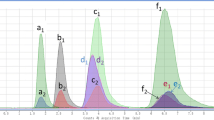Abstract
A modified quick, easy, cheap, effective, rugged, and safe (QuEChERS) method using multi-walled carbon nanotubes (MWCNTs) as sorbent solvent combined with HPLC was developed for the simultaneous determination of olaquindox, carbadox, mequindox, quinocetone, and cyadox in animal feeds. Sample preparation was performed by ultrasound-assisted extraction (UAE) with methanol-acetonitrile-H2O (50:25:25, v/v/v) as extraction solvent and a final clean-up using QuEChERS with MWCNTs (30–50 nm) as the sorbent solvent. To achieve the optimum conditions for extraction the target analytes and modified QuEChERS toward target analytes, several parameters, including extraction solvent and time as well as the type and amount of the adsorbents were investigated. The detection and quantification of five quinoxalines were performed by HPLC-UV. The chromatographic separation was performed on a C18 column using methanol-water as the mobile phase. The limits of detection and quantification of the analytes ranged from 0.2 to 0.4 and 1.0 to 1.5 mg/kg, respectively. The recoveries from spiked sample ranged from 66.0 to 95.6% with the relative standard deviations of less than 14.1%. The developed method was successfully utilized to monitor real samples, demonstrating that it is simple, fast, and robust, and may be used to monitor quinoxalines residues in animal feeds.




Similar content being viewed by others
References
Anastassiades M, Lehotay SJ, Stajnbaher D, Schenck FJ (2003) Fast and easy multiresidue method employing acetonitrile extraction/partitioning and "dispersive solid-phase extraction" for the determination of pesticide residues in produce. J AOAC Int 86:412–431
dos Ramos FJ, da Silveira IN, de Graaf G (1991) Column liquid chromatographic determination of carbadox and olaquindox in feeds. J Chromatogr 558:125–130
FAO/WHO (1990) Joint expert committee on food additives: evaluation of certain veterinary drug residues in food, Technical Series, 799, 2331
Gizzi G, Vincent U, von Holst C, de Jong J, Genouel C (2007) Validation of an analytical method for the determination of carbadox and olaquindox in feedstuff by liquid chromatography coupled to UV and/or diode array detection. Food Addit Contam 24:1226–1235. doi:10.1080/02652030701405544
Hao H, Guo W, Iqbal Z, Cheng G, Wang X, Dai M, Huang L, Wang Y, Peng D, Liu Z, Yuan Z (2013) Impact of cyadox on human colonic microflora in chemostat models. Regul Toxicol Pharmacol 67:335–343. doi:10.1016/j.yrtph.2013.08.011
He Q, Fang B, Su Y, Zeng Z, Yang J, He L, Zeng D (2013) Simultaneous determination of quinoxaline-1,4-dioxides in feeds using molecularly imprinted solid-phase extraction coupled with HPLC. J Sep Sci 36:301–310. doi:10.1002/jssc.201200701
Huang C, Lei H, Zhao X, Tang H, Wang Y (2013) Metabolic influence of acute cyadox exposure on Kunming mice. J Proteome Res 12:537–545. doi:10.1021/pr301033a
Huang L, Lin Z, Zhou X, Zhu M, Gehring R, Riviere JE, Yuan Z (2015) Estimation of residue depletion of cyadox and its marker residue in edible tissues of pigs using physiologically based pharmacokinetic modeling. Food Addit Contam Part A Chem Anal Control Expo Risk Assess 32:2161. doi:10.1080/19440049.2015.1100330
Huang L, Xiao A, Fan S, Yin J, Chen P, Liu D, Qiu Y, Wang Y, Yuan Z (2005) Development of liquid chromatographic methods for determination of quinocetone and its main metabolites in edible tissues of swine and chicken. J AOAC Int 88:472–478
Huang Q, Ihsan A, Guo P, Luo X, Cheng G, Hao H, Chen D, Jamil F, Tao Y, Wang X, Yuan Z (2016) Evaluation of the safety of primary metabolites of cyadox: acute and sub-chronic toxicology studies and genotoxicity assessment. Regul Toxicol Pharmacol 74:123–136. doi:10.1016/j.yrtph.2015.11.011
Hutchinson MJ, Young PB, Kennedy DG (2005) Confirmatory method for the analysis of carbadox and olaquindox in porcine feedingstuffs using LC-electrospray MS-MS. Food Addit Contam 22:113–119. doi:10.1080/02652030400028001
Kesiūnaite G, Naujalis E, Padarauskas (2008) Matrix solid-phase dispersion extraction of carbadox and olaquindox in feed followed by hydrophilic interaction ultra-high-pressure liquid chromatographic analysis. J Chromatogr A 1209:83–87. doi:10.1016/j.chroma.2008.09.025
Le T, Zhu L, Shu L, Zhang L (2016) Simultaneous determination of five quinoxaline-1,4-dioxides in animal feeds using an immuno chromatographic strip. Food Addit Contam Part A Chem Anal Control Expo Risk Assess 33:244–251. doi:10.1080/19440049.2015.1124461
Lin SY, Jeng SL (2001) High-performance liquid chromatographic determination of carbadox, olaquindox, furazolidone, nitrofurazone, and nitrovin in feed. J Food Prot 64:1231–1234
Song J, Qiao X, Chen H, Zhao D, Zhang Y, Xu Z (2011) Molecularly imprinted solid-phase extraction combined with high-performance liquid chromatography for analysis of trace olaquindox residues in chick feeds. J Sci Food Agric 91:2378–2385. doi:10.1002/jsfa.4471
Souza Dibai WL, de Alkimin Filho JF, da Silva Oliveira FA, Sampaio de Assis DC, Camargos Lara LJ, de Figueiredo TC, de Vasconcelos Cancado S (2015) HPLC-MS/MS method validation for the detection of carbadox and olaquindox in poultry and swine feeding stuffs. Talanta 144:740–744. doi:10.1016/j.talanta.2015.07.029
Thorpe VA (1980) Sample preparation of carbadox, furazolidone, nitrofurazone, and ethopabate in medicated feeds for high pressure liquid chromatography. J Assoc Off Anal Chem 63:981–984
Wu Y, Wang Y, Yuan Z (2006) Simultaneous determination of five quinoxaline-1,4-dioxides in animal feeds using ultrasonic solvent extraction and high-performance liquid chromatography. Anal Chim Acta 569:97–102. doi:10.1016/j.aca.2006.03.092
Xu Z, Song J, Li L, Qiao X, Chen H (2012) Development of an on-line molecularly imprinted chemiluminescence sensor for determination of trace olaquindox in chick feeds. J Sci Food Agric 92:2696–2702. doi:10.1002/jsfa.5690
Zhang H, Zhang Z, Hu Y, Yang X, Yao S (2011) Synthesis of a novel composite imprinted material based on multiwalled carbon nanotubes as a selective melamine absorbent. J Agric Food Chem 59:1063–1071. doi:10.1021/jf104064y
Zhao L, Zhang L, Liu F, Xue X, Pan C (2014) Multiresidue analysis of 16 pesticides in jujube using gas chromatography and mass spectrometry with multiwalled carbon nanotubes as a sorbent. J Sep Sci 37:3362–3369. doi:10.1002/jssc.201400499
Zhao P, Wang L, Zhou L, Zhang Z, Kang S, Pan CP (2012) Multi-walled carbon nanotubes as alternative reversed-dispersive solid phase extraction materials in pesticide multi-residue analysis with QuEChERS method. J Chromatogr A 1225:17–25. doi:10.1016/j.chroma. 2011.12.070
Zou N, Gu K, Liu S, Hou Y, Zhang J, Xu X, Li X, Pan C (2016) Rapid analysis of pesticide residues in drinking water samples by dispersive solid-phase extraction based on multiwalled carbon nanotubes and pulse glow discharge ion source ion mobility spectrometry. J Sep Sci 39:1202–1212. doi:10.1002/jssc. 201501258
Acknowledgements
This work was supported by Special Fund for Agro-scientific Research in the Public Interest (No. 201203040) and 2016 National Risk Assessment of Quality and Safety of Livestock and Poultry Products (GJFP2016007).
Author information
Authors and Affiliations
Corresponding authors
Ethics declarations
Conflict of Interest
Yi Zhao declares that he has no conflict of interest. Tingting Yue declares that she has no conflict of interest. Tanfei Tao declares that he has no conflict of interest. Wang Xu declares that he has no conflict of interest. Lingli Huang declares that she has no conflict of interest. Shuyu Xie declares that she has no conflict of interest. Yuanhu Pan declares that he has no conflict of interest. Dapeng Peng declares that he has no conflict of interest. Dongmei Chen declares that she has no conflict of interest. Zonghui Yuan declares that he has no conflict of interest.
Ethical Approval
This article does not contain any studies with human or animal subjects.
Informed Consent
Not applicable.
Rights and permissions
About this article
Cite this article
Zhao, Y., Yue, T., Tao, T. et al. Simultaneous Determination of Quinoxalines in Animal Feeds by a Modified QuEChERS Method with MWCNTs as the Sorbent Followed by High-Performance Liquid Chromatography. Food Anal. Methods 10, 2085–2091 (2017). https://doi.org/10.1007/s12161-016-0776-z
Received:
Accepted:
Published:
Issue Date:
DOI: https://doi.org/10.1007/s12161-016-0776-z




